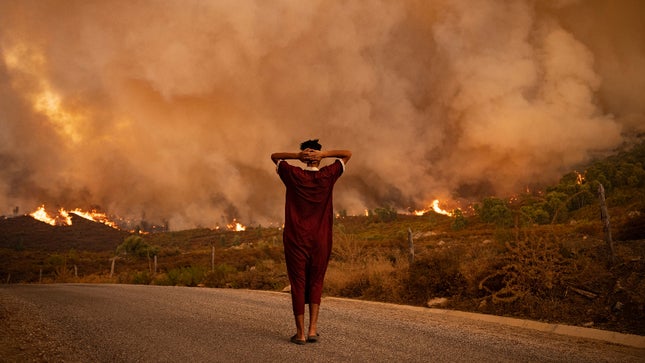
NEW DELHI: 21st century had a bad start. IPCC predicts the future is also hazy with dark emission clouds making cities close to inhabitable.
The Intergovernmental Panel on Climate Change (IPCC), the United Nations body for climate science, published the second installment of the Sixth Assessment Report (AR6) on Monday, February 28. The report titled ‘Climate Change 2022: Impacts, Adaptation, and Vulnerability’ has subtly warned the world of how global leaders have failed in protecting over half of the world’s population, which is on the verge of losing their homes due to inhabitable conditions. “Atlas of human suffering”, stated António Guterres, Secretary-General, UN while commenting on the report. The IPCC report explicitly defines how climate change has the potential of essentially converting the earth into an inhabitable hotbox.
Impact on city life
Climate change, when combined with increased urbanisation, will present cities with new issues. “Growing urbanisation and climate change together pose complicated dangers, particularly for places with poorly planned urban growth, high levels of poverty and unemployment, and a lack of essential amenities,” said Debra Roberts, Working Group Co-Chair, IPCC.
Several Indian cities and states, including Mumbai, Ahmedabad, Bihar, and Punjab, are susceptible hotspots, according to the IPCC assessment, with a high probability of extreme events ranging from flooding to heat stress. Furthermore, this will result in more people being displaced due to climate change. According to reports, the fatality rate from floods, droughts, and storms in Africa, South Asia, and Central and South America would be 15 times higher between 2010 and 2020.
The report warned that India is one of the most vulnerable countries on a global level in terms of the population affected by the sea-level rise. If the emissions levels continue to soar high, then over 35 million people in India could face annual coastal flooding by the middle of the century. The numbers could rise to over 50 million people and damages amounting up to $24 billion. Mumbai, India’s financial capital, in damage control from sea-level rise may spend up to $162 billion a year by 2050.
Surge in Wet-bulb temperature
The report notes that Indian cities will experience intolerable conditions with increased heat and humidity if the emissions are not rapidly reduced. Wet-bulb temperatures, a measure that combines heat and humidity, are mentioned in the report. Even for fit and healthy adults, the present wet-bulb temperature of 31 degrees Celsius is exceedingly harmful, while a temperature of 35 degrees is unsurvivable for more than six hours.
According to the IPCC, wet-bulb temperatures in India rarely exceed 31 degrees Celsius at the moment, with majority of the country seeing maximum wet-bulb temperatures of 25-30 degrees Celsius. Many portions of northern and coastal India would attain extremely dangerous wet-bulb temperatures of over 31 degrees Celsius by the end of the century if emissions are decreased just to the levels now promised. Wet-bulb temperatures will approach or exceed the unsurvivable limit of 35 degrees Celsius throughout much of India if emissions continue to climb, with the bulk of the country experiencing wet-bulb temperatures of 31 degrees Celsius or higher.
What comes with a warmer globe?
Individuals’ physical health may also be jeopardised since illness transmission is expected to accelerate. The greatest threat comes from vector-borne and water-borne diseases like malaria, which are particularly prevalent in Asia’s sub-tropical regions, where warmer temperatures allow disease-carrying insects like mosquitoes to spread quickly.
In the coming decades, mortality from respiratory disorders, diabetes, infectious diseases, and other diseases is anticipated to rise. On the other hand, a rise in global temperature will result in a dramatic increase of new born mortality. The research emphasises on the impact of the climate issue on cities, which house more than half of the world’s population. Heatwaves, urban heat islands, excessive precipitation, and storms can all have a major impact on the people and infrastructure of the world’s overloaded cities.
Melting glaciers
The most vulnerable ecosystems on the planet are expected to be the hardest hit. According to the IPCC, glacial lake outburst floods will become more common in mountain regions, putting the lives of downstream inhabitants in peril. Recent events like the Chamoli disaster’s ice and rock avalanche, as well as cloudburst-like precipitation in Himachal Pradesh and Uttarakhand, have served as sharp reminders of this grim reality. In the future years, the IPCC predicts that glaciers in the Hindu Kush Himalaya region would melt at a faster rate. Meanwhile, as temperatures rise above 1.5°C, important river basins such as the Ganges and the Brahmaputra may experience more flooding. It will also have a devastating effect on world plant and animal species, who are already suffering from heatwaves, droughts, wildfires, and floods.
Furthermore, with a 1.5°C increase in global warming, nearly 14 per cent of the species analysed in the paper stand a high danger of extinction. If the temperature rises over this level, it will rise to 29 per cent. With cascading climate change, trees, corals, tidal marshes, seagrass meadows, planktons, and many more related communities will be on the verge of extinction.
Deterring global mental health
The IPCC stated that climate change and an increasing number of climate catastrophes have an effect on physical and psychological health. For the first time, the IPCC clarified that climate change poses a serious threat to mental health, including stress and trauma from frequent extreme weather events, loss of livelihoods, and even future stability on a much warmer globe.
Cities are the solution
Cities can play an important role in combating climate change. The important point is that reducing emissions, keeping a tight eye on deforestation operations, and planting more trees will all benefit the environment in the long run. “Cities also give chances for climate action,” Roberts states, “green buildings, reliable sources of clean water and renewable energy, and sustainable transportation networks that connect urban and rural areas may all lead to a more inclusive, fairer society.”

